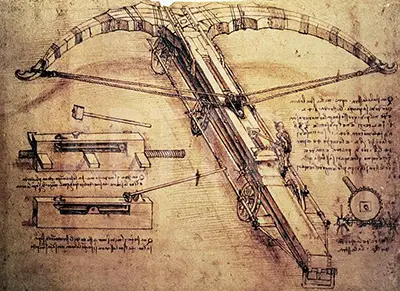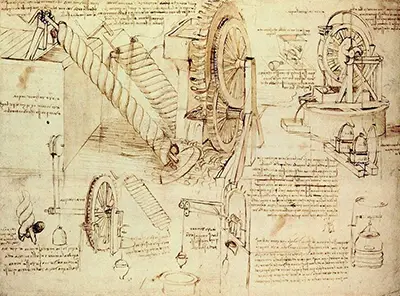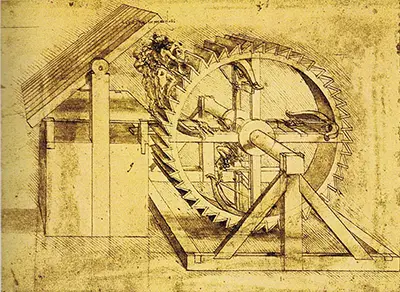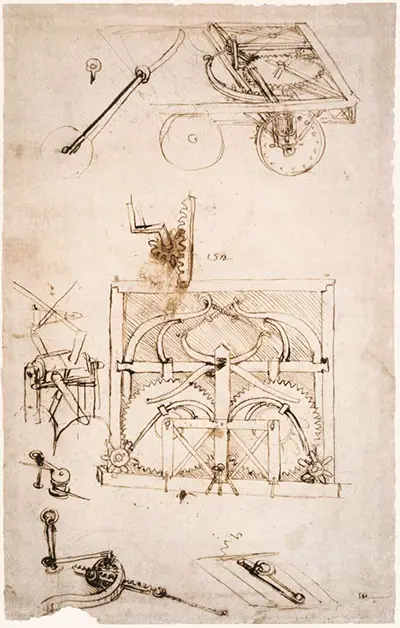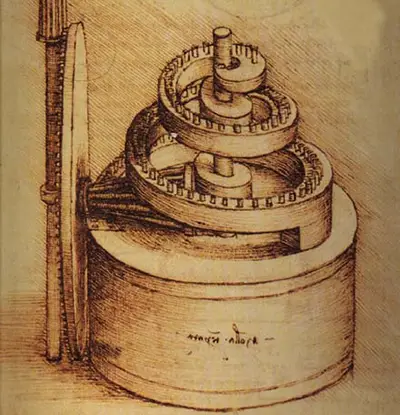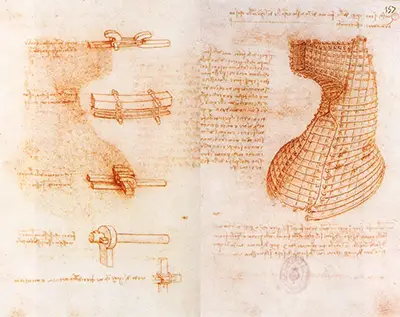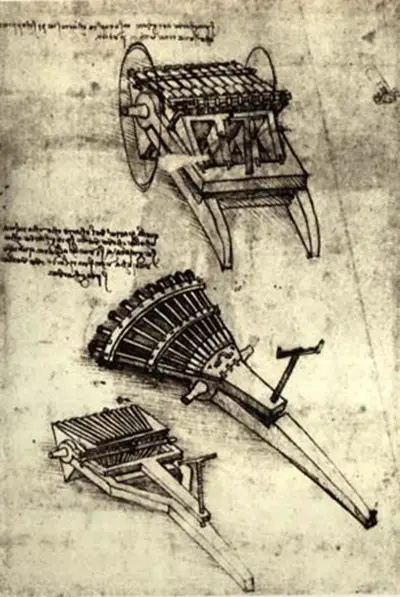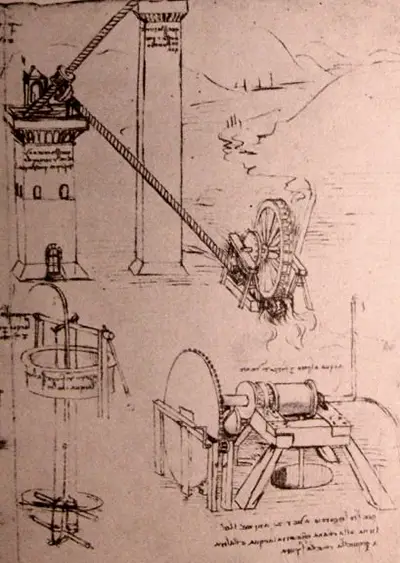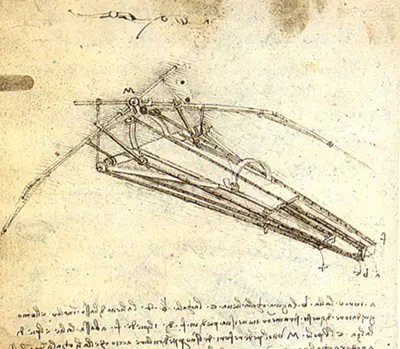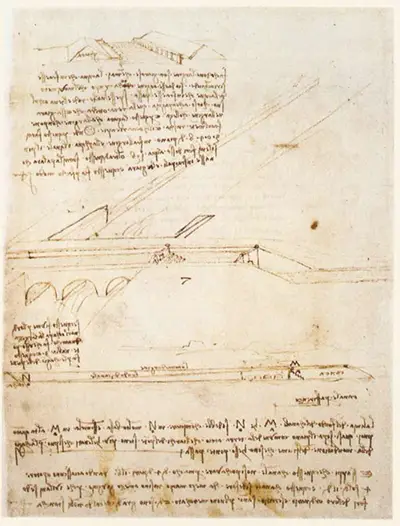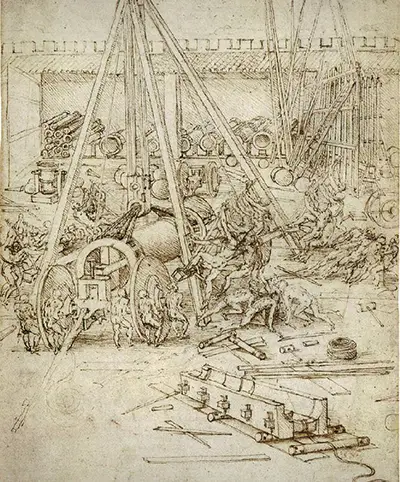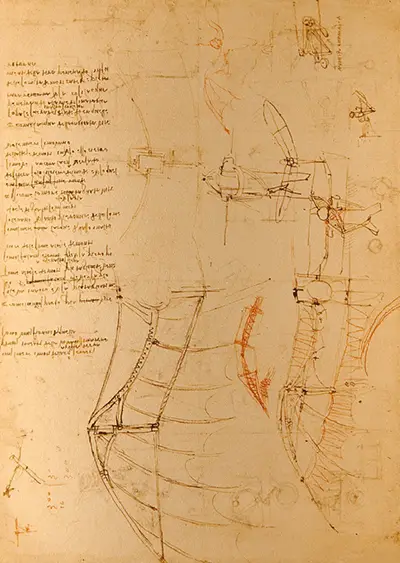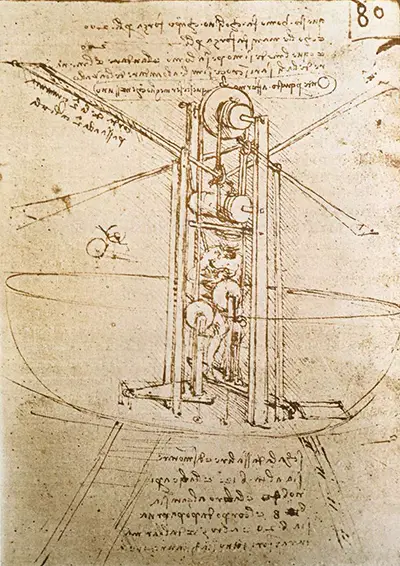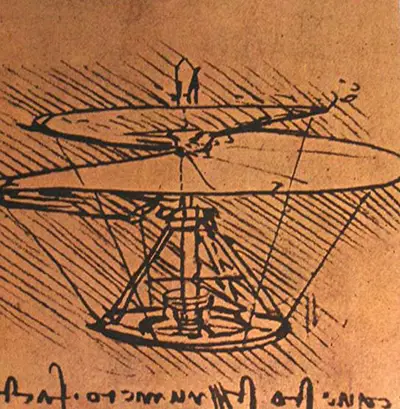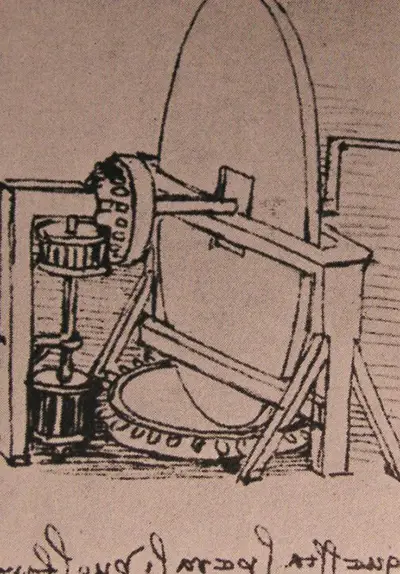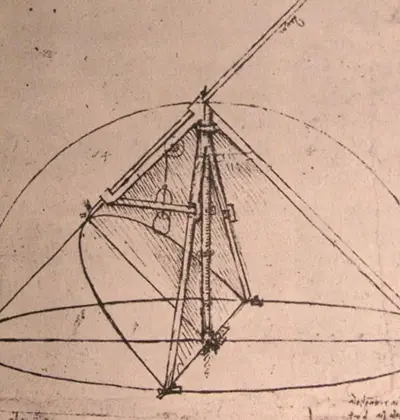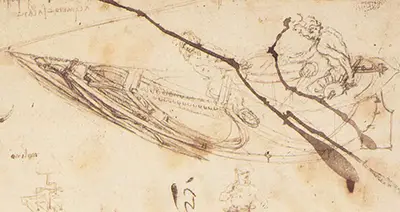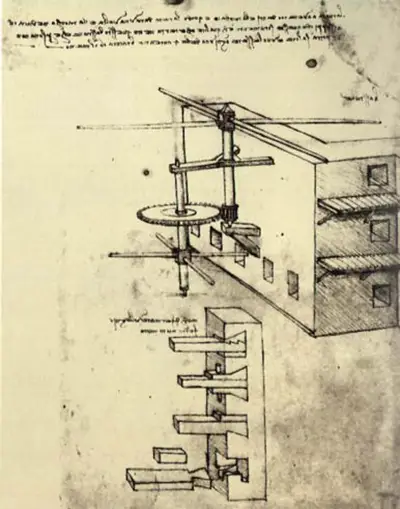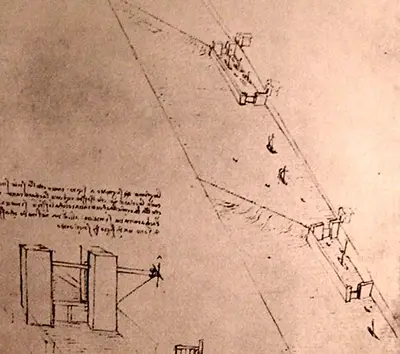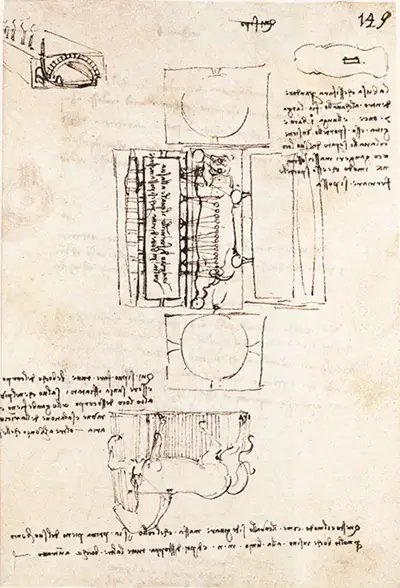This inventive mind combined his passion for engineering with renowned technical skills as a draughtsman to work as a consultant and designer on multiple projects.
There were clear themes to his work in this genre, covering flying machines, war machines, water and land machines plus an assortment of everyday, practical innovations.
The "Renaissance Man" also contributed significantly to science, mathematics, sculpture, painting, architecture and drawing. His inventions are a highly memorable segment of his vast career, and also offer clear links to modern day life.
The variety of his inventions was also another pointer at what many class as genius. Some would be commissioned projects to aid notable names of the 15th and 16 centuries. Others would purely be experimental ideas which da Vinci would explore for his own curiosity.
Da Vinci had an enviable understanding of engineering principles, making use of leverage/cantilevering, pulleys, cranks, gears, lubrication systems and bearings within various projects. His inventive mind went far beyond just being a gifted artist, as many still remember him.
Many of his technical drawings would include annotations alongside that would explain how the various combination of items would work together.
Leonardo da Vinci was entirely aware of the potential impact his inventions could make on the world. As quoted below, he was concerned by some of his designs falling into the wrong hands.
How by means of a certain machine many people may stay some time under water. How and why I do not describe my method of remaining under water, or how long I can stay without eating; and I do not publish nor divulge these by reason of the evil nature of men who would use them as means of destruction at the bottom of the sea, by sending ships to the bottom, and sinking them together with the men in them. And although I will impart others, there is no danger in them; because the mouth of the tube, by which you breathe, is above the water supported on bags of corks.
Famous Inventions of Leonardo da Vinci
It is often overlooked that Leonardo da Vinci invented so many things that are still in use today.
Perhaps because he was so famous for his art and philosophy or perhaps because there were many inventions he did not actually have the initial idea for, but developed them into what we know and use today.
Leonardo da Vinci always had a taste for exploring, and this can be seen in the inventions he made and developed. A look at some of the inventions of Leonardo da Vinci helps us to understand him more as a whole person when comparing to his art and philosophy.
The Anemometer
Leon Batista invented the first anemometer in 1450. The device measured windspeed and is still used today in various forms of aviation. Leonardo da Vinci had a life long love affair with the idea of flight. It was this that prompted him to make innovations to Leon Batista's design to make the measurement more accurate. Although not the inventor of the initial product, da Vinci's work on the anemometer is what has turned it into the instrument that we still use to this day. At some period between 1483 and 1486 da Vinci made numerous alternations to the design so that it was easier to measure wind force. Not only did these changes make it easier, they also made it more accurate.
What changes did Leonardo da Vinci make?
The variations Leonardo da Vinci made to make the device more accurate were to add in and arched frame and a wooden block attached to it. When the wind blows the wooden block raises and anyone reading the device can measure the scale which is printed on the side of the wooden block. This is what measures the windspeed more accurately than the previous design.
Flying Machine
Leonardo da Vinci's undisputed favourite area of study was aviation. As well as his inventions this is evident in his paintings and philosophy. He was truly excited by the prospect of humans being able to soar above the skies like birds, so it is little wonder that the flying machine was one of his most treasured inventions. Even though it never got made in the form he invented it - his idea was the basis of modern aviation. Maybe the Wright Brothers did not use his original design from his sketches, but the simple idea of humans being able to use a machine to fly certainly would not have come to pass if da Vinci had not initially thought it up.
Leonardo da Vinci's flying machine has the pilot lying face down in a winged device that is obviously inspired by animals capable of flight. It is items such as this which really sets da Vinci apart from Michelangelo's inventions. The two wings on da Vinci's flying machine actually have pointed ends which suggest he had studied the various forms of flight taken by animals and discovered that bats are one of the most efficient at using their wingspan. To power the wings the pilot would use pedals to crank a rod and pulley system that was attached to the wings. He also imagined a separate crank for increased power and a head piece which served as a steering wheel. Unfortunately the invention could not be made in practical application as the single pilot would not be able to create enough power to keep it in the air.
The Helicopter
The first helicopters were not invented until the 1940s, but like with the flying machine Leonardo da Vinci's designs are said to have had a huge influence on what designers used to create the first helicopter. Although Leonardo da Vinci never actually built or tested his helicopter, the design has many practical elements that are still seen on helicopter design today.
Because a central screw was essential to the design - da Vinci called his device an aerial screw. He stipulated that because the central screw was so important to the design it would need to be well made. He speculated that the screw could be made of linen so the pores could be stopped up with starch. Despite the simplicity of the design it may have been the size that set back de Vinci's ability to actually build this and get it off of the ground. Leonardo da Vinci's helicopter was 15ft in diameter and made from reed, linen and wire. If made, it would have taken four men to rotate the shaft with cranks.
The Parachute
The modern parachute as we know it today was credited to the inventor Sebastien Lenormand in 1783, however a few hundred years before this Leonardo da Vinci conceived the idea of a parachute. He made sketches that speculated if man had a "tent made from linen" that was the correct size for his proportions, he would be able to jump from any height without suffering injury. The distinguishing aspect of Leonardo da Vinci's design was that it was triangular rather than round. Many people have since speculated that this would not have provided enough resistance to help someone land safely on the ground. As well as the shape being questioned, da Vinci's original parachute design conceived that the wooden frame would be too heavy and would weigh down the device.
Although never tested by da Vinci, there have been some enthusiasts who have built and tried Leonardo da Vinci's original parachute design. In 2000 a man called Adrian Nichols created a parachute made from the design that da Vinci had sketched. Not only did it work in practice - but Adrian was quoted as saying he actually thought this design worked a lot better than a standard parachute.
Armoured Car
You wouldn't think that the tank or armoured car was first thought up by a man like Leonardo da Vinci but it was something he thought about in great detail. The car Leonardo da Vinci invented was the ability to carry a great number of weapons and move in any direction. Leonard da Vinci actually invented a great number of war machines but this was the most popular. The vehicle designed by da Vinci has a number of light cannons that were attached to a circular platform and would be able to rotate the full 360 degree range. A shell much like a turtle's covers and protects this area - which is one part of the design that is said to influence how modern tanks are designed now. Like many of Leonardo da Vinci's designs - the power needed to make it work was the main setback in getting it from the drawing stages to an actual vehicle. his design would have taken 8 men to power and the cranks would have needed to have been turned continuously to make it move.
Clock
Leonardo da Vinci did not actually invent the first clock, however like many things he innovated the design to make it more accurate. The original clock always showed hours and minutes like they do today - but this could not always be relied on to be accurate. The incorporation of a pendulum helped this, but it was da Vinci's innovations that really set the clock up to be as accurate as it is now.
What changes did Leonardo da Vinci make?
Leonardo da Vinci added separate mechanisms for the hours and the minutes. Weights, harnesses and gears elaborately connected together made up these mechanisms. Many clocks and watches today are still designed using these mechanisms - especially collectors analogue timepieces. He also added in springs rather than weights which is again something that is still practiced in timepiece design today.
Self Propelled Cart
Motorised vehicles were not designed as they are today by Leonardo da Vinci - but they were his idea. Much like his aviation ideas people would not have dared to dream about a self propelled cart until he did and sketched down his design. He envisaged a cart that was able to be propelled without being pushed which is essentially what we have in a car today. As well as flight and aviation, locomotion and transportation were one of Leonardo da Vinci's great interests. With the absence of a modern day engine da Vinci used springs in his design to power the cart to propel itself. His forward thinking design also had many of the things we see on modern cars like steering and brake capabilities.
Until late in the 20th century scholars actually struggled to understand da Vinci's design for a self propelled cart because it was so ahead of it's time and it exceeded expectation of capabilities in that time period. A museum in Italy built the design to test it's practical application in 2006 and to the surprise of many historians and the museum staff it actually worked.
Scuba Gear
Carrying on with the theme of exploration of land, da Vinci branched out into the sea to create a way for man to breathe underwater. This was actually one of his inventions that he speculated could be used for war as he imagined that it could be used for sneaking up on the enemy under water. Designed in 1500 when he was working in Venice, Leonardo da Vinci's scuba gear set was ahead of it's time like many of his inventions. The scuba gear consisted of a leather diving suit which is much like the diving suits used today - and mask that resembled a bag that went over the divers head. A system of tubes provided air to the diver that was below water. A valve operated ballon helped to operate the bag which gave it the ability to either be inflated or deflated by the user. this helped the diver either come to the surface or sink. There was also a pouch included in the sketch of the leather diving suit for the scuba diver to be able to urinate in.
Revolving Bridge
Bridges were by no means a new idea in da Vinci's time; but they were still incredibly basic. Da Vinci's idea for a revolving bridge was again something he saw armies being able to use in warfare. The idea was that you were able to use the bridge then pack it up and take it with you. The bridge swung across the body of water that you needed to cross and had wheels for quick transport. Like many of Leonardo da Vinci's inventions it worked mostly on a rope and pulley system. He used a counterweight system to balance out the weight of the bridge users to help with the balance when people were moving across it.
While making notes to go along with his sketches da Vinci commented that the bridge design he had created would be light but rugged in practical application. The bridge was actually designed for the Duke and was one of several he was asked to design for him during his lifetime. Leonardo da Vinci actually also built a similar bridge for armies which was more portable and faster to construct. Da Vinci often shared his thoughts about warfare in his work and one of the main things he felt the army needed to do to gain the upper hand on the enemy was to be more mobile. With his innovative designs he often believed he gave the army a 'one up' on the enemy.

